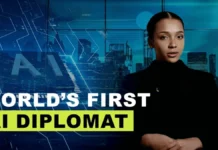Last week I had the pleasure of attending the International Communication Association’s 68th Annual Conference in Prague. My presentation focused on the digital and public diplomacy activities of the Palestinian government in the West Bank, specifically it’s Facebook Embassy to Israel. While presenting my work I mentioned that unlike other virtual Embassies, Palestine’s Facebook Embassy seems to stand the test of time as it is still active three years after being established.
Following the presentation, Prof. R.S. Zaharna of the American University asked me why so many digital initiatives, like virtual Embassies, are short-lived? Why is it that MFAs often announce grand digital initiatives that are abandoned within a few months?
This is a fascinating question whose answers can also illustrate the difficulty of practicing digital diplomacy.
Answer # 1- Digital Diplomacy is Resource Intensive
In 2015, the Israeli MFA launched a Twitter Embassy to the GCC, a group of six Gulf States that do not recognize Israel and have no bi-lateral ties with Israel. The MFA’s intention was to use the Embassy to engage directly with the populations of these Gulf States on a range of issues including Israeli scientific and cultural achievements, Israeli society and Israel’s foreign policies in the region. Moreover, the MFA intended to use the Embassy so as to bypass a very critical domestic media and narrate a positive image of Israel.
However, since its launch in 2015, Israel’s virtual Embassy has steadily become less active in terms of content publication and engagement with followers. Two-way conversations between the Embassy and its audiences have become rare while most content is generic in nature and not tailored to the unique attributes of Gulf citizens. Even digital “spectacles” such as online Q&A sessions with Israeli leaders have become infrequent.
The MFA thus seems to have abandoned the Embassy’s original goals using it as a one way channel for message dissemination. A possible reason for this outcome is that digital diplomacy is resource intensive. Once a virtual Embassy is launched content needs to be created, infographics and videos need to be produced, questions need to be answered and conversations need to take place. As digital diplomacy departments are usually understaffed, over-burdened and lacking in resources they soon find themselves abandoning digital initiatives and falling back on familiar and less intensive forms of digital diplomacy such as information dissemination and framing.
Answer #2- Administrations Change
Another reason why digital initiatives are often abandoned is that administrations change and with them so do diplomatic goals and diplomatic working routines. One notable example is Canada. Under Stephen Harper’s conservative government, Canadian digital diplomacy was seriously hampered as all online communications had to be approved by the Prime Minister’s office. As such, Embassies and diplomats could not converse in real-time with followers or comment on unfolding events. The government also focused on a digital initiative meant to facilitate democracy in Iran. Essentially, the Canadian government decided to help create a Digital Public Square where Iranian citizens could speak their minds free from the restrictions of the Iranian regime. The project rested on a collaboration between the government and the University of Toronto.
The election of Justin Trudeau led to an immediate change in digital diplomacy goals and working routines. Diplomats and Embassies were set free and no longer needed to have all content pre-approved. This brought on a flurry of digital activity. Since the restrictions have been lifted off Canadian diplomats the Digital Public Square project has become less prevalent on Canadian social media channels. This is not surprising. Why focus on a new digital square when Canadian diplomats can use existing digital diplomacy tools to interact with Iranians and promote democratic values?
Had the Harper government stayed in power, the trajectory of the Digital Square Project might have been different.
Answer # 3- Understanding Audiences
In 2015, the Hamas terror group decided to hold its first ever Twitter Q&A session. Twitter users from all over the world could ask questions regarding the group’s goals and ambitions, its policies opposite Israel and the prospects of reconciliation with the West Bank government. While people could have asked questions on policy issues, many used the event to berate the group, criticize it and condemn its actions. The Q&A was hijacked by both Israeli and Arab Twitter users. Israelis used the Hamas’ hashtag to blast the group for its terror activity. Arab users blasted Hamas for its unwillingness to form a unity government with the West Bank.
Some have wondered why Hamas bothered to hold the Q&A in the first place. One possible reason is that Hamas hoped to obtain some legitimacy as the ruler of the Gaza strip. By holding a Q&A session Hamas wanted to act like any other government. The Q&A would also demonstrate openness to criticism thus negating Hamas’ image as a ruthless terror group. Yet Hamas failed to account for the power that online audiences hold, and their volatile nature. Online audiences can accept or reject a digital diplomacy message, endorse or condemn a digital diplomacy campaign and engage with, or derail a digital diplomacy event. In this case, Hamas was rejected by audiences. The backlash and failure of the Q&A session even made headlines throughout the world. Rather than bestow legitimacy, it instigated a crisis of legitimacy.
Tellingly, Hamas has not held any Q&As since 2015.
Answer #4: Overestimating What Digital Capabilities
In some cases, MFAs and diplomats may misjudge the impact of digital tools. One such instance was the State Department’s Twitter Channel “Think Again Turn Away”. The channel was part of the Department’s CVE activities (Countering Violent Extremism) meant to dissuade people from joining Daesh, communicating with Daesh online or lending financial support to Daesh. One important goal of the Twitter channel was to expose Daesh lies and present it as a barbaric group of mercenaries rather than an omnipotent caliphate.
The assumption among some American diplomats was that a Twitter channel could impact people’s beliefs and their behaviors. Therefore, the channel documented cases of sexual violence by Daesh terrorists as well as its barbaric war crimes, its violence towards fellow Muslims, its hypocrisy and trade in stolen artifacts, its destruction of heritage sites and its loss of territory throughout Iraq and Syria. The goal was to have people think again about Daesh and then walk away from its grip.
Yet the State Department soon had to contend with the fact that altering someone’s behavior based solely on social media content is difficult at best and simply not plausible at worst. Changing people’s behaviors requires interactions, engagement, conversations and long term relationship building- not infographics.
Ironically, engagement and relationship building were the very building blocks of Daesh’s online recruitment efforts.
Answer # 5: Rapid Changes in Audience Preferences
Finally, another reason for the short life span of digital diplomacy initiatives is rapid changes in audience preferences. For instance, the majority of Americans in most age groups used to get their news from social media. As such, diplomats and Embassies tended to publish news from their country, or about their country, on social media. Over time, diplomats even began to curate information for their followers thus serving as information gatekeepers. Digital diplomacy activities focused on gathering, analyzing, creating and framing news as opposed to writing op-eds for newspapers or contributing to blog sites of popular citizen journalists.
Yet the growing rhetoric of fake news and disinformation has led to a seismic change in the behavior of some online audiences. Last year saw the largest growth in traditional media subscriptions in more than a decade. Importantly, it is millennials who are flocking back to traditional media news sites given their lack of trust of online content that can so easily be manipulated. This change will soon bring about new digital diplomacy initiatives and practices such as creating diplomatic blog platforms where audiences can get accurate information or diplomats’ writing op-eds for traditional and credible news sites.
Moreover, digital audiences rapidly migrate from one platform to another. Once an MFA has established and created a community on Instagram, he may quickly lose the community as its members all move onto Snapchat or Google +. As such, digital diplomacy often sees diplomats abandon initiatives, and communities, given the constant need to migrate and follow their target audiences.
There is an innate tension in digital diplomacy between push and pull, between pulling the audience to one’s pages and profiles and being pushed by the audience onto another platform.
Conclusions
Of all diplomatic practices, digital diplomacy seems to be the most susceptible to change. New administrations alter communications protocols; new platforms attract entire audience segments while new preferences redefine the goals of digital diplomats. All of these often lead diplomats and MFAs to abandon digital initiatives soon after these have been launched. Yet these changes might also suggest that diplomats need to focus, among other, on creating their own platforms and pulling audiences to these platforms. The promise of delivering timely, accurate and relevant analysis of world events may enable diplomats to do just that.












